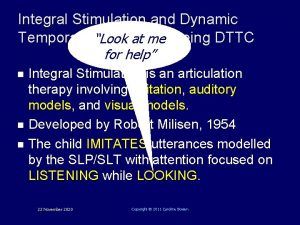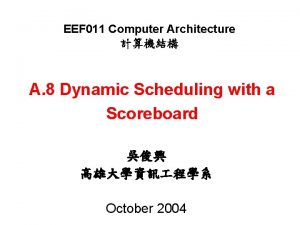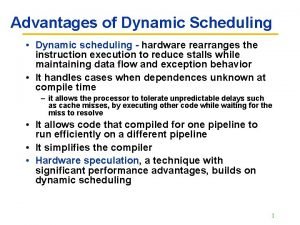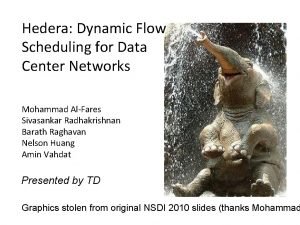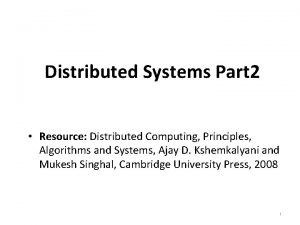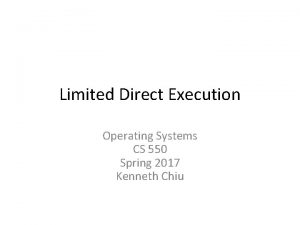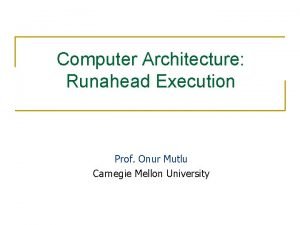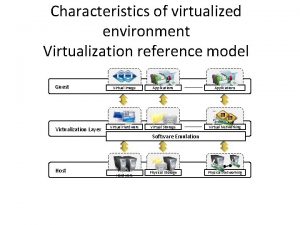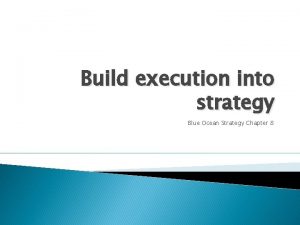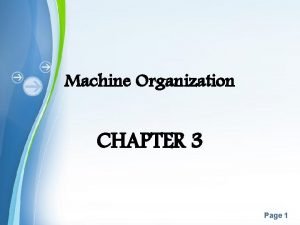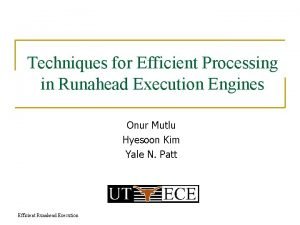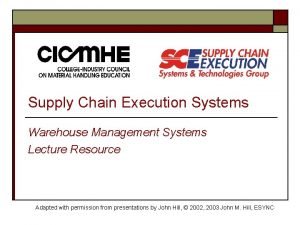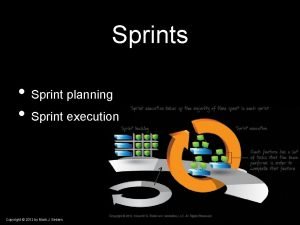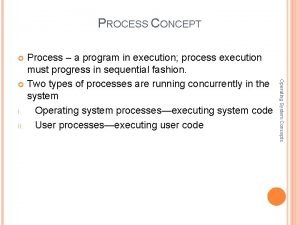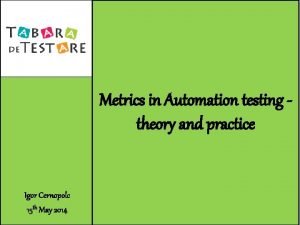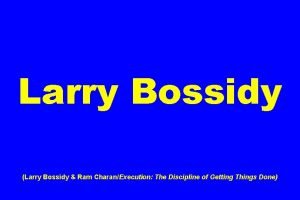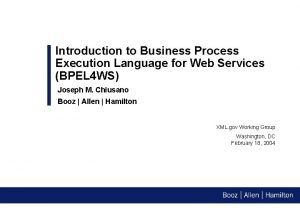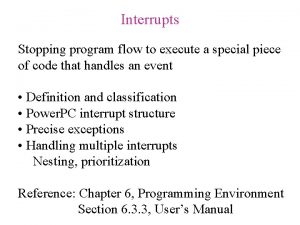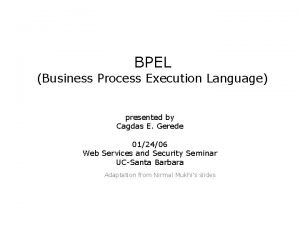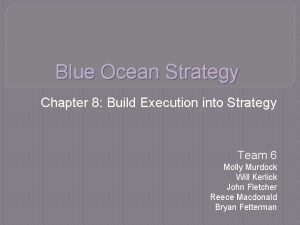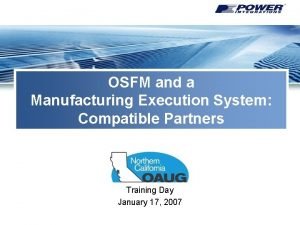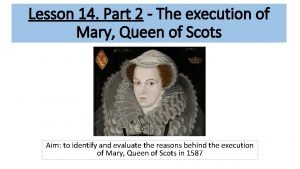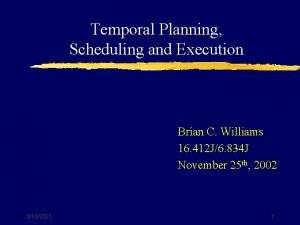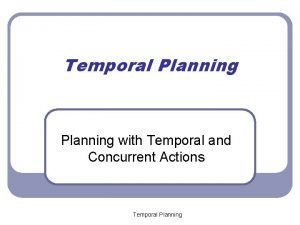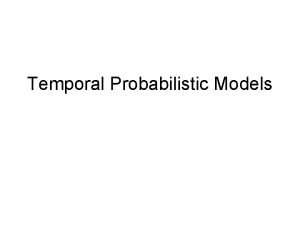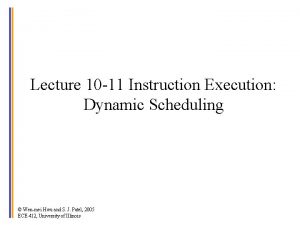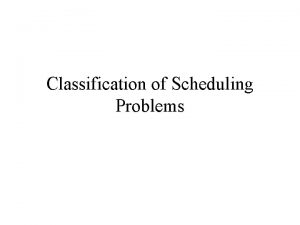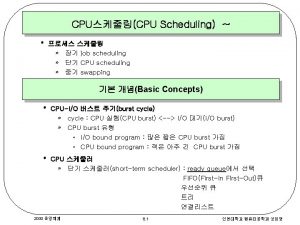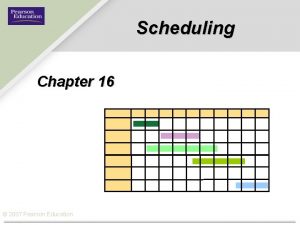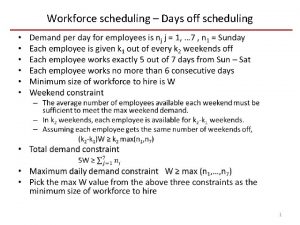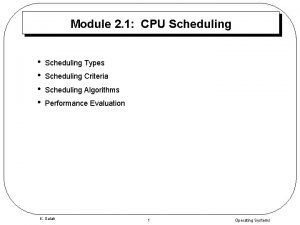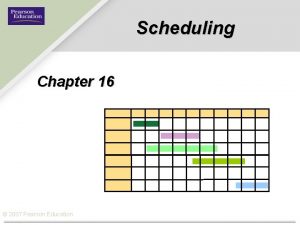Temporal Plan Execution Dynamic Scheduling and Simple Temporal









![TCSP Are Visualized Using Directed Constraint Graphs 0 [10, 20] 1 [30, 40] [60, TCSP Are Visualized Using Directed Constraint Graphs 0 [10, 20] 1 [30, 40] [60,](https://slidetodoc.com/presentation_image_h/283a1631f04c5ae6cd4154bb1fbdfbe3/image-10.jpg)












![Scheduling: Feasible Values Latest Times • X 1 in [10, 20] • X 2 Scheduling: Feasible Values Latest Times • X 1 in [10, 20] • X 2](https://slidetodoc.com/presentation_image_h/283a1631f04c5ae6cd4154bb1fbdfbe3/image-23.jpg)











![Executing Flexible Temporal Plans [Muscettola, Morris, Pell et al. ] Handling delays and fluctuations Executing Flexible Temporal Plans [Muscettola, Morris, Pell et al. ] Handling delays and fluctuations](https://slidetodoc.com/presentation_image_h/283a1631f04c5ae6cd4154bb1fbdfbe3/image-35.jpg)













![Dynamic Scheduling by Decomposition [0, 10] B 10 [-1, 1] A B D [0, Dynamic Scheduling by Decomposition [0, 10] B 10 [-1, 1] A B D [0,](https://slidetodoc.com/presentation_image_h/283a1631f04c5ae6cd4154bb1fbdfbe3/image-49.jpg)




























- Slides: 77

Temporal Plan Execution: Dynamic Scheduling and Simple Temporal Networks Brian C. Williams 16. 412 J/6. 834 J December 2 nd, 2002 3/6/2021 1

Goals and Environment Constraints Temporal Planner Temporal Network Solver Projective Task Expansion Temporal Plan Dynamic Scheduling and Task Dispatch Modes Model-based Programming & Execution Observations Task Dispatch Goals Task. Decomposition Execution Commands Reactive Task Expansion

Goals and Environment Constraints Temporal Planner Temporal Network Solver Projective Task Expansion Temporal Plan Dynamic Scheduling and Task Dispatch Modes Model-based Programming & Execution Observations Task Dispatch Goals Task. Decomposition Execution Commands Reactive Task Expansion

Outline • Temporal Representation – Qualitative temporal relations – Metric constraints – Temporal Constraint Networks – Temporal Plans • Temporal Reasoning for Planning and Scheduling • Flexible Execution through Dynamic Scheduling

Qualitative Temporal Constraints (Allen 83) • • x before y x meets y x overlaps y x during y x starts y x finishes y x equals y X Y X Y XY X Y X • • y after x y met-by x y overlapped-by x y contains x y started-by x y finished-by x y equals x

Example: Deep Space One Remote Agent Experiment Timer Max_Thrust Idle contained_by SEP_Segment Idle_Seg Th_Sega Th_Seg contained_by Th_Seg Idle_Seg contained_by Accum Thr_Boundary Accum_Thr Accum_NO_Thr equals SEP Action Accum_Thr Thr_Boundary equals meets Standby Start_Up Attitude Accum_Thr Thrust Standby Shut_Down Start_Up Thrust contained_by CP(Ips_Tvc) Poke Thrust Shut_Down CP(Ips_Tvc) Standby

Qualitative Temporal Constraints Maybe Expressed as Inequalities (Vilain, Kautz 86) • • x before y X+ < Y x meets y X+ = Y x overlaps y (Y- < X+) & (X- < Y+) x during y (Y- < X-) & (X+ < Y+) x starts y (X- = Y-) & (X+ < Y+) x finishes y (X- < Y-) & (X+ = Y+) x equals y (X- = Y-) & (X+ = Y+) Inequalities may be expressed as binary interval relations: X+ - Y- < [-inf, 0]

Metric Constraints • Going to the store takes at least 10 minutes and at most 30 minutes. → 10 < [T+(store) – T-(store)] < 30 • Bread should be eaten within a day of baking. → 0 < [T+(baking) – T-(eating)] < 1 day • Inequalities, X+ < Y- , may be expressed as binary interval relations: 1. - inf < [X+ - Y-] < 0

Metric Time: Quantitative Temporal Constraint Networks (Dechter, Meiri, Pearl 91) • A set of time points Xi at which events occur. • Unary constraints (a 0 < Xi < b 0 ) or (a 1 < Xi < b 1 ) or. . . • Binary constraints (a 0 < Xj - Xi < b 0 ) or (a 1 < Xj - Xi < b 1 ) or. . .
![TCSP Are Visualized Using Directed Constraint Graphs 0 10 20 1 30 40 60 TCSP Are Visualized Using Directed Constraint Graphs 0 [10, 20] 1 [30, 40] [60,](https://slidetodoc.com/presentation_image_h/283a1631f04c5ae6cd4154bb1fbdfbe3/image-10.jpg)
TCSP Are Visualized Using Directed Constraint Graphs 0 [10, 20] 1 [30, 40] [60, inf] 3 [10, 20] 2 [20, 30] [40, 50] [60, 70] 4

Simple Temporal Networks (Dechter, Meiri, Pearl 91) Simple Temporal Networks: • A set of time points Xi at which events occur. • Unary constraints (a 0 < Xi < b 0 ) or (a 1 < Xi < b 1 ) or. . . • Binary constraints (a 0 < Xj - Xi < b 0 ) or (a 1 < Xj - Xi < b 1 ) or. . . Sufficient to represent: • most Allen relations • simple metric constraints Can’t represent: • Disjoint tokens

Simple Temporal Network • Tij = (aij£ Xi - Xj £ bij) 0 [10, 20] 1 [30, 40] [60, inf] 3 [10, 20] 2 [20, 30] [40, 50] [60, 70] 4

A Completed Plan Forms an STN

Outline • Temporal Representation • Temporal Reasoning for Planning and Scheduling – TCSP Queries – Induced Constraints – Plan Consistency – Static Scheduling • Flexible Execution through Dynamic Scheduling

TCSP Queries (Dechter, Meiri, Pearl, AIJ 91) • Is the TCSP consistent? • What are the feasible times for each Xi? • What are the feasible durations between each Xi and Xj? • What is a consistent set of times? • What are the earliest possible times? • What are the latest possible times?

TCSP Queries (Dechter, Meiri, Pearl, AIJ 91) • Is the TCSP consistent? Planning • What are the feasible times for each Xi? • What are the feasible durations between each Xi and Xj? • What is a consistent set of times? Scheduling • What are the earliest possible times? Scheduling • What are the latest possible times?

To Query an STN Map to a Distance Graph Gd = < V, Ed > Edge encodes an upper bound on distance to target from source. Xj - Xi £ bij Xi - Xj £ - aij Tij = (aij£ Xj - Xi £ bij) 0 [10, 20] 1 [30, 40] 3 0 20 -10 1 [10, 20] 2 [40, 50] [60, 70] 40 -30 -10 20 4 2 -60 70 3 50 -40 4

Gd Induces Constraints • Path constraint: i 0 =i, i 1 =. . . , ik = j → Conjoined path constraints result in the shortest path as bound: where dij is the shortest path from i to j

Shortest Paths of Gd 0 20 -10 40 1 -30 -10 20 3 -60 70 d-graph 2 50 -40 4

STN Minimum Network d-graph STN minimum network

Conjoined Paths are Computed using All Pairs Shortest Path (e. g. , Floyd-Warshall’s algorithm ) 1. for i : = 1 to n do dii 0; 2. for i, j : = 1 to n do dij aij; 3. for k : = 1 to n do 4. for i, j : = 1 to n do 5. dij min{dij, dik + dkj}; i k j

Testing Plan Consistency No negative cycles: -5 > TA – TA = 0 0 20 -10 40 1 -30 -10 20 3 -60 70 d-graph 2 50 -40 4
![Scheduling Feasible Values Latest Times X 1 in 10 20 X 2 Scheduling: Feasible Values Latest Times • X 1 in [10, 20] • X 2](https://slidetodoc.com/presentation_image_h/283a1631f04c5ae6cd4154bb1fbdfbe3/image-23.jpg)
Scheduling: Feasible Values Latest Times • X 1 in [10, 20] • X 2 in [40, 50] • X 3 in [20, 30] • X 4 in [60, 70] Earliest Times d-graph

Scheduling without Search: Solution by Decomposition • Select value for 1 à 15 d-graph [10, 20]

Scheduling without Search: Solution by Decomposition • Select value for 1 à 15 d-graph [10, 20]

Solution by Decomposition • Select value for 1 à 15 • Select value for 2, consistent with 1 à 45 d-graph [40, 50], 15+[30, 40]

Solution by Decomposition • Select value for 1 à 15 • Select value for 2, consistent with 1 à 45 d-graph [45, 50]

Solution by Decomposition • Select value for 1 à 15 • Select value for 2, consistent with 1 à 45 d-graph [45, 50]

Solution by Decomposition • Select value for 1 à 15 • Select value for 2, consistent with 1 à 45 • Select value for 3, consistent with 1 & 2 d-graph à 30 [20, 30], 15+[10, 20], 45+[-20, -10]

Solution by Decomposition • Select value for 1 à 15 • Select value for 2, consistent with 1 à 45 • Select value for 3, consistent with 1 & 2 d-graph à 30 [25, 30]

Solution by Decomposition • Select value for 1 à 15 • Select value for 2, consistent with 1 à 45 • Select value for 3, consistent with 1 & 2 d-graph à 30 [25, 30]

Solution by Decomposition • Select value for 1 à 15 • Select value for 2, consistent with 1 à 45 • Select value for 3, consistent with 1 & 2 d-graph O(N 2) à 30 • Select value for 4, consistent with 1, 2 & 3

Outline • Temporal Representation • Temporal Reasoning for Planning and Scheduling • Flexible Execution through Dynamic Scheduling

Goals and Environment Constraints Temporal Planner Temporal Network Solver Projective Task Expansion Temporal Plan Dynamic Scheduling and Task Dispatch Modes Model-based Programming & Execution Observations Task Dispatch Goals Task. Decomposition Execution Commands Reactive Task Expansion
![Executing Flexible Temporal Plans Muscettola Morris Pell et al Handling delays and fluctuations Executing Flexible Temporal Plans [Muscettola, Morris, Pell et al. ] Handling delays and fluctuations](https://slidetodoc.com/presentation_image_h/283a1631f04c5ae6cd4154bb1fbdfbe3/image-35.jpg)
Executing Flexible Temporal Plans [Muscettola, Morris, Pell et al. ] Handling delays and fluctuations in task duration: • Least commitment temporal plans leave room to adapt EXECUTIVE CONTROLLED SYSTEM • flexible execution adapts through dynamic scheduling • Assigns time to event when executed.

Issues in Flexible Execution 1. How do we minimize execution latency? 2. How do we schedule at execution time?

Time Propagation Can Be Costly EXECUTIVE CONTROLLED SYSTEM

Time Propagation Can Be Costly EXECUTIVE CONTROLLED SYSTEM

Time Propagation Can Be Costly EXECUTIVE CONTROLLED SYSTEM

Time Propagation Can Be Costly EXECUTIVE CONTROLLED SYSTEM

Time Propagation Can Be Costly EXECUTIVE CONTROLLED SYSTEM

Time Propagation Can Be Costly EXECUTIVE CONTROLLED SYSTEM

Issues in Flexible Execution 1. How do we minimize execution latency? è Propagate through a small set of neighboring constraints. 2. How do we schedule at execution time?

Compile to Efficient Network EXECUTIVE CONTROLLED SYSTEM

Compile to Efficient Network EXECUTIVE CONTROLLED SYSTEM

Compile to Efficient Network EXECUTIVE CONTROLLED SYSTEM

Issues in Flexible Execution 1. How do we minimize execution latency? è Propagate through a small set of neighboring constraints. 2. How do we schedule at execution time?

Issues in Flexible Execution 1. How do we minimize execution latency? è Propagate through a small set of neighboring constraints. 2. How do we schedule at execution time? è Through decomposition?
![Dynamic Scheduling by Decomposition 0 10 B 10 1 1 A B D 0 Dynamic Scheduling by Decomposition [0, 10] B 10 [-1, 1] A B D [0,](https://slidetodoc.com/presentation_image_h/283a1631f04c5ae6cd4154bb1fbdfbe3/image-49.jpg)
Dynamic Scheduling by Decomposition [0, 10] B 10 [-1, 1] A B D [0, 10] C -1 A 1 0 -2 C [-2, 2] 10 Simple Example 0 D 2 Equivalent Distance Graph Representation

Dynamic Scheduling by Decomposition • Compute APSP graph • Decomposition enables assignment without search 11 10 -1 B 0 A 0 -1 1 C 10 10 1 B D -2 -1 A 0 1 0 -2 C 2 -2 Equivalent All Pairs Shortest Paths (APSP) Representation 10 D 2 Equivalent Distance Graph Representation

Assignment by Decomposition 11 10 <0, 10> -1 B t=0 0 A 0 -1 1 C 10 <0, 10> -2 1 D -2 2 <2, 11>

Assignment by Decomposition 11 t=3 10 -1 B <0, 0> 0 A 0 -1 1 C 10 <0, 10> -2 1 D -2 2 <2, 11>

Assignment by Decomposition Solution: But C now has to be executed at t =2, which is already in the past! • Assignments must monotonically increase in value. è Execute first, all APSP neighbors with negative delays. 10 11 t=3 -1 B <0, 0> 0 A 0 -1 1 C 10 <2, 2> -2 1 D -2 2 <4, 4>

Dispatching Execution Controller Execute an event when enabled and active • Enabled - APSP Predecessors are completed – Predecessor – a destination of a negative edge that starts at event. • Active - Current time within bound of task.

Dispatching Execution Controller Initially: • E = Time points w/o predecessors • S = {} Repeat: 1. Wait until current_time has advanced st EXECUTIVE a. Some TP in E is active b. All time points in E are still enabled. 2. Set TP’s execution time to current_time. 3. Add TP to S. 4. Propagate time of execution to TP’s APSP immediate neighbors. 5. Add to A, all immediate neighbors that became enabled. a. TPx enabled if all negative edges starting at TPx have their destination in S.

Propagation is Focused • Propagate forward along positive edges to tighten upper bounds. – forward prop along negative edges is useless. • Propagate backward along negative edges to tighten lower bounds. –Backward prop along positive edges useless.

Propagation Example S = {A} 11 <0, 0> A 10 -1 0 9 B 1 -1 C -2 -1 1 D -2 2

Propagation Example S = {A} 11 <1, 10> <0, 0> A 10 -1 0 9 B 1 -1 C -2 -1 1 D -2 2

Propagation Example S = {A} 11 <1, 10> <0, 0> A 10 -1 0 9 B 1 -1 C <0, 9> -2 -1 1 D -2 2

Propagation Example S = {A} 11 <1, 10> <0, 0> A 10 -1 0 9 B 1 -1 C <0, 9> -2 -1 <2, 11> 1 D -2 2

Propagation Example S = {A} E= {C} 11 <1, 10> <0, 0> A 10 -1 0 9 B 1 -1 C <0, 9> -2 -1 <2, 11> 1 D -2 2

Reducing Execution Latency Filtering: Execution time is O(n) • some edges are redundant • worst case • remove redundant edges • best case 11 10 t=3 -1 B <0, 0> 0 A 0 -1 1 C 10 <0, 10> -2 1 D -2 2 <2, 11>

• Edge Dominance – Eliminate edge that is redundant due to the triangle inequality AB + BC = AC 150 A B -100 80 -50 100 C -20

• Edge Dominance – Eliminate edge that is redundant due to the triangle inequality AB + BC = AC 150 A B -100 80 -50 100 C -20

• Edge Dominance – Eliminate edge that is redundant due to the triangle inequality AB + BC = AC 150 A B -100 80 -50 C -20

• Edge Dominance – Eliminate edge that is redundant due to the triangle inequality AB + BC = AC 150 A -100 80 -50 C B

An Example of Edge Filtering • Start off with the APSP network 11 A 10 -1 0 9 B 1 -1 C -2 1 -1 D -2 2

An Example of Edge Filtering • Start at A-B-C triangle 11 A 10 -1 0 9 B 1 -1 C -2 1 -1 D -2 2

An Example of Edge Filtering • Look at B-D-C triangle 11 -1 A 0 9 B 1 -1 C -2 1 -1 D -2 2

An Example of Edge Filtering • Look at B-D-C triangle 11 -1 A 0 9 B 1 -1 C 1 -1 D -2 2

An Example of Edge Filtering • Look at D-A-B triangle 11 -1 A 0 9 B 1 -1 C 1 -1 D 2

An Example of Edge Filtering • Look at D-A-C triangle 11 B A 0 9 1 -1 C 1 -1 D 2

An Example of Edge Filtering • Look at B-C-D triangle B A 0 9 1 -1 C 1 -1 D 2

An Example of Edge Filtering • Look at B-C-D triangle B A 0 9 1 -1 C 1 -1 D

An Example of Edge Filtering • Resulting network has less edges than the original A 9 C 1 1 B -1 -1 0 10 0 A 0 10 -1 B 1 C D -2 2 D

Avoiding Intermediate Graph Explosion Problem: • APSP consumes O(n 2) space. Solution: • Interleave process of APSP construction with edge elimination – Never have to build whole APSP graph

Goals and Environment Constraints Temporal Planner Temporal Network Solver Projective Task Expansion Temporal Plan Dynamic Scheduling and Task Dispatch Modes Model-based Programming & Execution Observations Task Dispatch Goals Task. Decomposition Execution Commands Reactive Task Expansion
 Sjn scheduling
Sjn scheduling Dynamic symbolic execution
Dynamic symbolic execution Dttc cueing hierarchy
Dttc cueing hierarchy Dynamic work scheduling
Dynamic work scheduling Dynamic scheduling in computer architecture
Dynamic scheduling in computer architecture Advantages of dynamic programming
Advantages of dynamic programming Dynamic scheduling in computer architecture
Dynamic scheduling in computer architecture Scoreboard dynamic scheduling
Scoreboard dynamic scheduling Hedera: dynamic flow scheduling for data center networks
Hedera: dynamic flow scheduling for data center networks Dynamic dynamic - bloom
Dynamic dynamic - bloom Simple present, simple past, simple future
Simple present, simple past, simple future Direct and manage project execution
Direct and manage project execution The gulf of evaluation
The gulf of evaluation Design fifo and non fifo execution
Design fifo and non fifo execution Process and execution
Process and execution Project management chapter 4
Project management chapter 4 Ppbe timeline
Ppbe timeline Phases of shooting a basketball
Phases of shooting a basketball Siklus interaksi
Siklus interaksi Plessy v ferguson
Plessy v ferguson A mob's illegal seizure and execution of a person.
A mob's illegal seizure and execution of a person. A mob's illegal seizure and execution of a person.
A mob's illegal seizure and execution of a person. Gulf of execution and evaluation
Gulf of execution and evaluation Specification gap is gap between
Specification gap is gap between Present simple past simple future
Present simple past simple future Simple past simple present simple future
Simple past simple present simple future Present simple present continuous past simple future simple
Present simple present continuous past simple future simple Past simple future simple present simple
Past simple future simple present simple Present continuous present simple exercises
Present continuous present simple exercises Future tense of work
Future tense of work Simple present tense exemplos
Simple present tense exemplos Present simple past simple future simple
Present simple past simple future simple Production planning and inventory control
Production planning and inventory control The secrets to successful strategy execution
The secrets to successful strategy execution Execution defects
Execution defects Vision without execution is hallucination
Vision without execution is hallucination Asp.net execution model
Asp.net execution model In this scheme cpu execution waits while i/o proceeds.
In this scheme cpu execution waits while i/o proceeds. Ia64 itanium
Ia64 itanium Limited direct execution protocol
Limited direct execution protocol Runahead execution
Runahead execution Machine reference model of execution virtualization
Machine reference model of execution virtualization The process of recruiting and retaining capable employees
The process of recruiting and retaining capable employees My intuition is telling me there be better days
My intuition is telling me there be better days Btechsmartclass
Btechsmartclass Build execution into strategy
Build execution into strategy Portfolio selection process
Portfolio selection process Java applications begin execution at method
Java applications begin execution at method Basic machine organization
Basic machine organization Execution graphique de la cotation
Execution graphique de la cotation Zach anders
Zach anders Cognitive hurdle
Cognitive hurdle Overcome key organizational hurdles
Overcome key organizational hurdles Execution styles in advertising
Execution styles in advertising Mai lai massacre primary sources
Mai lai massacre primary sources Yue minjun biography
Yue minjun biography Business process execution language for web services
Business process execution language for web services Monitoring in voyage planning
Monitoring in voyage planning Visualfactory
Visualfactory Runahead execution
Runahead execution What is a supply chain execution system
What is a supply chain execution system Sprint execution
Sprint execution A process is a program in execution
A process is a program in execution Automation testing kpis
Automation testing kpis Lean manufacturing d365
Lean manufacturing d365 Discipline of the ram
Discipline of the ram Business process execution language for web services
Business process execution language for web services Program flow control with interrupts
Program flow control with interrupts Sim instruction in 8085
Sim instruction in 8085 Contoh tahap inisiasi proyek
Contoh tahap inisiasi proyek His execution horrified much of europe
His execution horrified much of europe Business process execution language
Business process execution language Build execution into strategy
Build execution into strategy Various addressing modes of 8086 microprocessor
Various addressing modes of 8086 microprocessor Empno ename sal a822 ramaswamy
Empno ename sal a822 ramaswamy Execution power
Execution power Mary queen of scots execution lesson
Mary queen of scots execution lesson Execution power
Execution power


